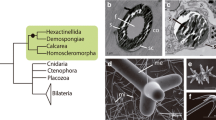Abstract
Silicatein genes are known to be involved in siliceous spicule formation in marine sponges. Proteins encoded by these genes, silicateins, were recently proposed for nanobiotechnological applications. We studied silicatein genes of marine sponges Latrunculia oparinae collected in the west Pacific region, shelf of Kuril Islands. Five silicatein genes, LoSilA1, LoSilA1a, LoSilA2, and LoSilA3 (silicatein-α group), LoSilB (silicatein-β group), and one cathepsin gene, LoCath, were isolated from the sponge L. oparinae for the first time. The deduced amino acid sequence of L. oparinae silicateins showed high-sequence identity with silicateins described previously. LoCath contains the catalytic triad of amino acid residues Cys-His-Asn characteristic for cathepsins as well as motifs typical for silicateins. A phylogenetic analysis places LoCath between sponge silicateins-β and L-cathepsins suggesting that the LoCath gene represents an intermediate form between silicatein and cathepsin genes. Additionally, we identified, for the first time, silicatein genes (AcSilA and AcSilB) in nonspicule-forming marine sponge, Acаnthodendrilla sp. The results suggest that silicateins could participate also in the function(s) unrelated to spiculogenesis.



Similar content being viewed by others
References
Altschul S, Gish W, Miller W, Myers E, Lipman D (1990) Basic local alignment search tool. J Mol Biol 215:403–410
Berti P, Storer A (1995) Alignment/phylogeny of the papain superfamily of cysteine proteases. J Mol Biol 246:273–283
Brutchey RL, Morse DE (2008) Silicatein and the translation of its molecular mechanism of biosilicification into low temperature nanomaterial synthesis. Chem Rev 108:4915–4934
Cha J, Shimizu K, Zhou Y, Christiansen S, Chmelka B, Stucky G, Morse D (1999) Silicatein filaments and subunits from a marine sponge direct the polymerization of silica and silicones in vitro. Proc Natl Acad Sci USA 96:361–365
Chomczynski P, Sacchi N (1987) Single-step method of RNA isolation by acid guanidinium thiocyanate-phenol-chloroform extraction. Anal Biochem 162:156–159
Ehrlich H, Worch H (2007a) Collagen: a huge matrix in glass sponge flexible spicules of the meter-long Hyalonema sieboldi. In: Bäuerlein E (ed) Handbook of biomineralization. Wiley VCH, Weinheim, pp 23–41
Ehrlich H, Worch H (2007b) Sponges as natural composites: from biomimetic potential to development of new biomaterials. In: Custodio MR, Lobo-Hajdu G, Hajdu E, Muricy G (eds) Porifera research: biodiversity, innovation and sustainability. Museu National, Rio de Janeiro, Brasil, pp 303–312
Ehrlich H, Krautter M, Hanke T, Simon P, Knieb C, Heinemann S, Worch H (2007) First evidence of the presence of chitin in skeletons of marine sponges. Part II. Glass sponges (Hexactinellida: Porifera). J Exp Zool (Mol Dev Evol) 308B:437–483
Ehrlich H, Heinemann S, Heinemann C, Simon P, Bazhenov VV, Shapkin NP, Born R, Tabachnick KR, Hanke T, Worch H (2008a) Nanostructural organization of naturally occurring composites—Part I: silica–collagen-based biocomposites. J Nanomater. doi:10.1155/2008/623838
Ehrlich H, Janussen D, Simon P, Bazhenov V, Shapkin NP, Erler C, Mertig M, Born R, Heinemann S, Hanke T, Worch H, Vournakis JN (2008b) Nanostructural organization of naturally occurring composites. Part II. Silica–chitin-based biocomposites. J Nanomater. doi:10.1155/2008/670235
Fairhead M, Johnson K, Kowatz T, McMahon S, Carter L, Oke M, Liu H, Naismith J, van der Walle C (2008) Crystal structure and silica condensing activities of silicatein alpha–cathepsin L chimeras. Chem Commun (Camb) 15:1765–1767
Heinemann S, Erhlich H, Knieb C, Hanke T (2007) Biogenetically inspired hybrid materials based on silicified collagen. Int J Mat Res 98:603–608
Kaluzhnaya O, Belikov S, Schröder H, Wiens M, Giovine M, Krasko A, Müller I, Müller W (2005) Dynamics of skeleton formation in the Lake Baikal sponge Lubomirskia baicalensis. Part II. Molecular biological studies. Naturwissenschaften 92:134–138
Krasko A, Lorenz B, Batel R, Schröder H, Müller I, Müller W (2000) Expression of silicatein and collagen genes in the marine sponge Suberites domuncola is controlled by silicate and myotrophin. Eur J Biochem 267:4878–4887
Laemmli UK (1970) Cleavage of structural proteins during the assembly of the head of bacteriophage T4. Nature 227:680–685
Matz M, Shagin D, Bogdanova O, Lukyanov S, Diatchenko L, Chenchik A (1999) Amplification of cDNA ends based on template-switching effect and step-out PCR. Nucleic Acids Res 2:1558–1560
Mohri K, Nakatsukasa M, Masuda Y, Agata K, Funayama N (2008) Toward understanding the morphogenesis of siliceous spicules in freshwater sponge: differential mRNA expression of spicule-type-specific silicatein genes in Ephydatia fluviatilis. Dev Dyn 237:3024–3039
Morse DE (1999) Silicon biotechnology: harnessing biological silica production to construct new materials. Trends Biotechnol 17:230–232
Pozzolini M, Sturla L, Cerrano C, Bavestrello G, Camardella L, Parodi A, Raheli F, Benatti U, Müller W, Giovine M (2004) Molecular cloning of silicatein gene from marine sponge Petrosia ficiformis (Porifera, Demospongiae) and development of primmorphs as a model for biosilicification studies. Mar Biotechnol (NY) 6:594–603
Samaai T, Krasokhin V (2002) Latrunculia oparinae sp. nov. (Demospongiae, Poecilosclerida, Latrunculiidae) from the Kurile Islands, Sea of Okhotsk, Russia. Beaufortia 52:95–101
Schröder H, Brandt D, Schlobmacher U, Wang X, Tahir M, Tremel W, Belikov S, Müller W (2007) Enzymatic production of biosilica glass using enzymes from sponges: basic aspects and application in nanobiotechnology (material sciences and medicine). Naturwissenschaften 94:339–359
Schröder H, Wang X, Tremel W, Ushijima H, Müller W (2008) Biofabrication of biosilica-glass by living organisms. Nat Prod Rep 25:455–74
Shimizu K, Cha J, Stucky G, Morse D (1998) Silicatein α: cathepsin L-like protein in sponge biosilica. Proc Natl Acad Sci USA 95:6234–6238
Tamura K, Dudley J, Nei M, Kumar S (2007) MEGA4: Molecular Evolutionary Genetics Analysis (MEGA) software version 4.0. Mol Biol Evol 24:1596–1599
Acknowledgments
This work was supported by a grant from the Grant Program “Creation, investigation, and modeling of biogenic and biomimetic nanomaterials” of the Far Eastern Branch of Russian Academy of Sciences.
Author information
Authors and Affiliations
Corresponding author
Rights and permissions
About this article
Cite this article
Kozhemyako, V.B., Veremeichik, G.N., Shkryl, Y.N. et al. Silicatein Genes in Spicule-Forming and Nonspicule-forming Pacific Demosponges. Mar Biotechnol 12, 403–409 (2010). https://doi.org/10.1007/s10126-009-9225-y
Received:
Accepted:
Published:
Issue Date:
DOI: https://doi.org/10.1007/s10126-009-9225-y




